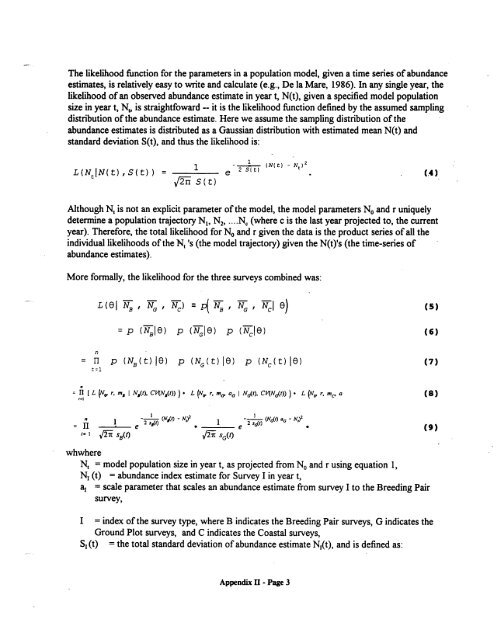A. Status of the Spectacled Eider - U.S. Fish and Wildlife Service
A. Status of the Spectacled Eider - U.S. Fish and Wildlife Service
A. Status of the Spectacled Eider - U.S. Fish and Wildlife Service
Create successful ePaper yourself
Turn your PDF publications into a flip-book with our unique Google optimized e-Paper software.
The likelihood function for <strong>the</strong> parameters in a population model, given a time series <strong>of</strong>abundance<br />
estimates, is relatively easy to write <strong>and</strong> calculate (e.g., De la Mare, 1986). In any single year, <strong>the</strong><br />
likelihood <strong>of</strong>an observed abundance estimate in year t, N(t), given a specified model population<br />
size in year t, N,, is straightfoward -- it is <strong>the</strong> likelihood function defined by <strong>the</strong> assumed sampling<br />
distribution <strong>of</strong> <strong>the</strong> abundance estimate. Here we assume <strong>the</strong> sampling distribution <strong>of</strong><strong>the</strong><br />
abundance estimates is distributed as a Gaussian distribution with estimated mean N(t) <strong>and</strong><br />
st<strong>and</strong>ard deviation 5(t), <strong>and</strong> thus <strong>the</strong> likelihood is:<br />
1 2<br />
1 - ____ (N(t) -Ne)<br />
L(N~IN(t),S(t)) = e 2 S(t) (.4)<br />
~‘ThS(t)<br />
Although N, is not an explicit parameter <strong>of</strong><strong>the</strong> model, <strong>the</strong> model parameters N 0 <strong>and</strong> r uniquely<br />
determine a population trajectory N1, 2 N~ (where c is <strong>the</strong> last year projected to, <strong>the</strong> current<br />
year). Therefore, <strong>the</strong> total likelihood for N0 <strong>and</strong> r given <strong>the</strong> data is <strong>the</strong> product series <strong>of</strong>all <strong>the</strong><br />
individual likelihoods <strong>of</strong><strong>the</strong> N, ‘s (<strong>the</strong> model trajectory) given <strong>the</strong> N(t)’s (<strong>the</strong> time-series <strong>of</strong><br />
abundance estimates).<br />
More formally, <strong>the</strong> likelihood for <strong>the</strong> three surveys combined was:<br />
L(8I NB, N, N) n (5)<br />
= p (NBIO) p (NGIO) p (NJ8) (6)<br />
n<br />
= H p (NB(t) 18) p (NG(t)18) p (N~(t)I8) (7)<br />
t=i<br />
- II LL(AT.r. m1 N,(r).C~N~(t))). L(NQ. r,m6,a0 I N0Q), CV(N~p))). L(NQ. r, m~.a (B)<br />
2 -~ (NJ:) a~ - N)2<br />
-H<br />
I<br />
e 2 sit) • e 2sJt) (9)<br />
- (NQ) - p~)<br />
t- I v’~ s<br />
8(t) vI~i S~3(t)<br />
whwhere<br />
N, = model population size in year t, as projected from N0 <strong>and</strong> r using equation 1,<br />
N1 (t) = abundance index estimate for Survey I in year t,<br />
a1 = scale parameter that scales an abundance estimate from survey Ito <strong>the</strong> Breeding Pair<br />
survey,<br />
I index <strong>of</strong><strong>the</strong> survey type, where B indicates <strong>the</strong> Breeding Pair surveys, G indicates <strong>the</strong><br />
Ground Plot surveys, <strong>and</strong> C indicates <strong>the</strong> Coastal surveys,<br />
S~ (t) = <strong>the</strong> total st<strong>and</strong>ard deviation <strong>of</strong> abundance estimate N1(t), <strong>and</strong> is defined as:<br />
Appendix II- Page 3

















